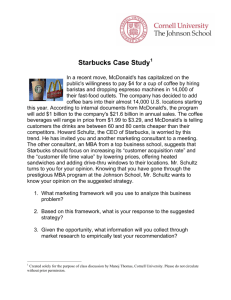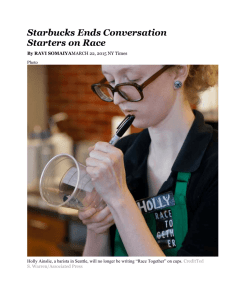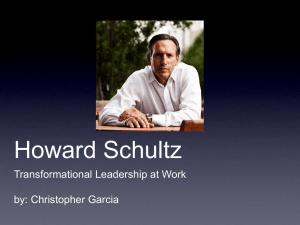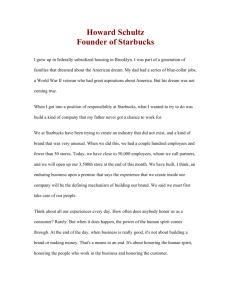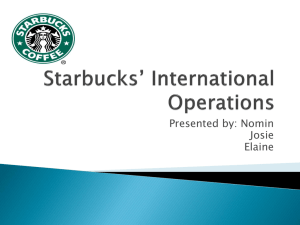Read more about Howard Schultz by Nitin Sharma
advertisement
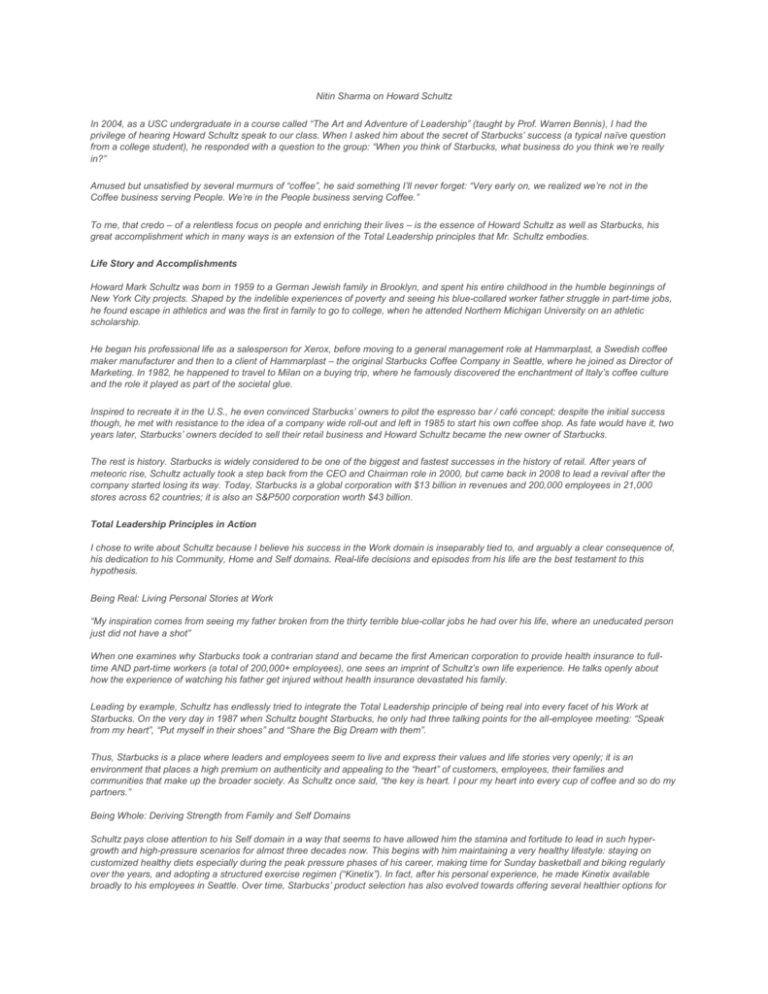
Nitin Sharma on Howard Schultz In 2004, as a USC undergraduate in a course called “The Art and Adventure of Leadership” (taught by Prof. Warren Bennis), I had the privilege of hearing Howard Schultz speak to our class. When I asked him about the secret of Starbucks’ success (a typical naïve question from a college student), he responded with a question to the group: “When you think of Starbucks, what business do you think we’re really in?” Amused but unsatisfied by several murmurs of “coffee”, he said something I’ll never forget: “Very early on, we realized we’re not in the Coffee business serving People. We’re in the People business serving Coffee.” To me, that credo – of a relentless focus on people and enriching their lives – is the essence of Howard Schultz as well as Starbucks, his great accomplishment which in many ways is an extension of the Total Leadership principles that Mr. Schultz embodies. Life Story and Accomplishments Howard Mark Schultz was born in 1959 to a German Jewish family in Brooklyn, and spent his entire childhood in the humble beginnings of New York City projects. Shaped by the indelible experiences of poverty and seeing his blue-collared worker father struggle in part-time jobs, he found escape in athletics and was the first in family to go to college, when he attended Northern Michigan University on an athletic scholarship. He began his professional life as a salesperson for Xerox, before moving to a general management role at Hammarplast, a Swedish coffee maker manufacturer and then to a client of Hammarplast – the original Starbucks Coffee Company in Seattle, where he joined as Director of Marketing. In 1982, he happened to travel to Milan on a buying trip, where he famously discovered the enchantment of Italy’s coffee culture and the role it played as part of the societal glue. Inspired to recreate it in the U.S., he even convinced Starbucks’ owners to pilot the espresso bar / café concept; despite the initial success though, he met with resistance to the idea of a company wide roll-out and left in 1985 to start his own coffee shop. As fate would have it, two years later, Starbucks’ owners decided to sell their retail business and Howard Schultz became the new owner of Starbucks. The rest is history. Starbucks is widely considered to be one of the biggest and fastest successes in the history of retail. After years of meteoric rise, Schultz actually took a step back from the CEO and Chairman role in 2000, but came back in 2008 to lead a revival after the company started losing its way. Today, Starbucks is a global corporation with $13 billion in revenues and 200,000 employees in 21,000 stores across 62 countries; it is also an S&P500 corporation worth $43 billion. Total Leadership Principles in Action I chose to write about Schultz because I believe his success in the Work domain is inseparably tied to, and arguably a clear consequence of, his dedication to his Community, Home and Self domains. Real-life decisions and episodes from his life are the best testament to this hypothesis. Being Real: Living Personal Stories at Work “My inspiration comes from seeing my father broken from the thirty terrible blue-collar jobs he had over his life, where an uneducated person just did not have a shot” When one examines why Starbucks took a contrarian stand and became the first American corporation to provide health insurance to fulltime AND part-time workers (a total of 200,000+ employees), one sees an imprint of Schultz’s own life experience. He talks openly about how the experience of watching his father get injured without health insurance devastated his family. Leading by example, Schultz has endlessly tried to integrate the Total Leadership principle of being real into every facet of his Work at Starbucks. On the very day in 1987 when Schultz bought Starbucks, he only had three talking points for the all-employee meeting: “Speak from my heart”, “Put myself in their shoes” and “Share the Big Dream with them”. Thus, Starbucks is a place where leaders and employees seem to live and express their values and life stories very openly; it is an environment that places a high premium on authenticity and appealing to the “heart” of customers, employees, their families and communities that make up the broader society. As Schultz once said, “the key is heart. I pour my heart into every cup of coffee and so do my partners.” Being Whole: Deriving Strength from Family and Self Domains Schultz pays close attention to his Self domain in a way that seems to have allowed him the stamina and fortitude to lead in such hypergrowth and high-pressure scenarios for almost three decades now. This begins with him maintaining a very healthy lifestyle: staying on customized healthy diets especially during the peak pressure phases of his career, making time for Sunday basketball and biking regularly over the years, and adopting a structured exercise regimen (“Kinetix”). In fact, after his personal experience, he made Kinetix available broadly to his employees in Seattle. Over time, Starbucks’ product selection has also evolved towards offering several healthier options for customers all over the world. Thus, he has integrated his dedication to health with his work and broadened the scope of the impact from self to employees to customers. In 2000, he stepped back from the CEO role, which was a very conscious decision for two reasons: he wanted to explore other endeavors and dreams ranging from different restaurant concepts to venture capital investing to philanthropy, and secondly, he wanted to spend more time with his family. Thus, he avoided any neglect of the Home/Family and Self domains. He has been happily married to Sheri Schultz for over 30 years and has two kids. While they integrate their Family and Community domains through engaging in philanthropic activities together in the Seattle area, Schultz also practices clear separation of the Family domain by dedicating time away from everything else and being generally very protective of the family’s privacy. Being Innovative: Community at the Heart of Starbucks’ Turnaround Schultz has also regularly gone back to the ethos or essence of Starbucks – that of being a Third Place, separate from homes and offices, where community is reinforced. When he returned to lead the company in 2008, despite the plethora of short-term challenges, he undertook a unique experiment to shake things up. “I decided--against the advice of many people at the time, because it had a high cost attached to it--to take 10,000 store managers to New Orleans. I knew that if I could remind people of our character and values, we could make a difference.” Schultz adds that these efforts “represented the single largest block of community support in the history of New Orleans” and contributed more than 54,000 volunteer hours and $1 million in local projects. He went on to state that if it hadn't been for this experiment, Starbucks wouldn't have turned things around: “It was real, it was truthful, and it was about leadership”. These episodes and others clearly demonstrate that Schultz’s success has in large part come from his application of Total Leadership principles. On numerous occasions, he has taken risks and eschewed a singular focus on short-term shareholder value, but in the process, cultivated such strong relationships and loyalties across all stakeholders, and thus generated monumental long-term shareholder value as well. I close with the very recent incident which has brought Schultz into limelight once again. When a shareholder openly challenged him at the Starbucks annual conference, blaming the company’s support for gay rights as a reason for declining sales in some territories, Schultz passionately defended what in his mind is “not an economic decision"; he challenged the complainant to sell his shares and went back to why it is essential for Starbucks to embrace diversity of all kinds, looking through the lens of its 200,000 people. After all, Starbucks is in the People business. Lessons for My Life I am inspired by Schultz example, and have come away convinced that his success is because of, not despite, integration of domains. The first lesson for me is to continue to reflect upon, develop more conviction around, and openly express my core values. I believe I have a way to go to be “really real”, whereby I can seamlessly weave my values and life stories into my future actions and decisions. Secondly, I am more motivated to also follow my own passion for community impact in India – especially around education, opportunity and social justice, and to integrate it with my work in several different ways over time. Ultimately, I believe I will fully dedicate myself towards such causes (through public service), but I must be careful to not ignore possible integrations in the next few years while I strive for success in business or investing. Finally, it is easy to note how Schultz has maintained a healthy focus on Self and Family, come what may. I am further encouraged in terms of my own current experiments, all of which have to do with becoming a healthier individual who is more integrated with family. References: http://www.nytimes.com/books/first/s/schultz-pour.html http://en.wikipedia.org/wiki/Howard_Schultz#cite_note-7 http://www.referenceforbusiness.com/businesses/M-Z/Schultz-Howard.html http://www.evancarmichael.com/Famous-Entrepreneurs/643/The-Coffee-King-Howard-Schultz-is-Born.html http://community.seattletimes.nwsource.com/archive/?date=19961215&slug=2365201 http://calorielab.com/news/2008/09/09/howard-schultz-of-starbucks-goes-on-a-diet-takes-company-along/ http://www.huffingtonpost.com/2010/07/16/starbucks-howard-schultz_n_649385.html http://www.johnsadowsky.com/leaders-who-use-their-life-stories-howard-schultz-of-starbucks/
